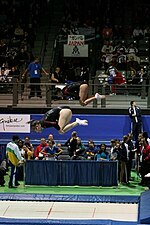A trampoline is a gymnastic and recreational device consisting of a piece of taut, strong fabric stretched over a steel frame using many coiled springs to provide a rebounding force which propels the jumper high into the air. In a trampoline, the fabric is not elastic itself; the elasticity is provided by the springs which connect it to the frame.
Link to video of Trampoline in Athens[]
http://www.youtube.com/watch?v=S_Nns4CRknY&feature=related
Link to page about Olympic Trampoline[]
http://www.infoplease.com/spot/summer-olympics-trampoline.html
History[]
Early trampoline-like devices[]
It could be said that a kind of trampolining was done by the Inuit people who used to toss each other into the air on a walrus skin, something like the sheet used by firemen to catch people jumping out of burning buildings. There also is some evidence of people in Europe having been tossed into the air by a number of people holding a blanket; Mak in the Wakefield Second Shepherds' Play and Sancho Panza in Don Quixote are both subjected to blanketing -- however, these are clearly non-voluntary, non-recreational instances of quasi-judicial, mob-administered punishment. The 19th century circus poster on which the Beatles' song Being for the Benefit of Mr. Kite is based references performance on trampoline, though the device is thought to have been something more like a springboard than the fabric-&-coiled-springs apparatus in use at present.
These may not be the true antecedents of the modern sport of trampolining, but it is certain that in the early years of the 20th century some acrobats used a "bouncing bed" on the stage to amuse audiences. The bouncing bed was in reality a form of small trampoline covered by bedclothes on which the acrobats performed mostly comedy routines.
According to circus folklore, the trampoline was supposedly first developed by an artiste called Du Trampolin who saw the possibility of using the trapeze safety net as a form of propulsion and landing device and experimented with different systems of suspension, eventually reducing the net to a practical size for separate performance. While there were trampoline like devices used for shows and in the circus, the story of Du Trampolin is probably a myth and no documentary evidence has been found to support it.
The first modern trampolines[]
The first modern trampoline was built by George Nissen and Larry Griswold around 1934. Nissen was a gymnastics and diving competitor and Griswold was a tumbler on the gymnastics team, both at the University of Iowa, USA. They had observed trapeze artists using a tight net to add entertainment value to their performance and experimented by stretching a piece of canvas, in which they had inserted grommets along each side, to an angle iron frame by means of coiled springs. It was initially used to train tumblers but soon became popular in its own right. Nissen explained that the name came from the Spanish trampolín meaning a diving board. George Nissen heard the word on a demonstration tour in Mexico in the late 1930s and decided to use an anglicized form as the trademark for the apparatus.[1] However, there is also an 18th century Italian word trampolino meaning springboard, from trampoli meaning stilts which could also be a source.[2]
In 1942 Griswold and Nissen created the Griswold-Nissen Trampoline & Tumbling Company, and began making trampolines commercially in Cedar Rapids, Iowa.
Use in flight and astronaut training[]
During World War II, the United States Navy Flight School developed the use of the trampoline in its training of pilots and navigators, giving them concentrated practice in spatial orientation that had not been possible before[3]. After the war, the development of the space flight programme again brought the trampoline into use to help train both American and Soviet astronauts, giving them experience of variable body positions in flight.
Competitive sports[]

Girls competing in synchronised trampoline
- Main article: trampolining
The competitive gymnastic sport of trampolining has been developed and it has been part of the Olympic Games since 2000. On a modern competitive trampoline a skilled athlete can bounce to a height of up to ten metres, performing multiple somersaults and twists. Trampolines also feature in the competitive sport of Slamball, a variant of basketball, and Bossaball, a variant of volleyball.
Cross-training for other sports[]
There are a number of other sports which use trampolines to help develop and hone acrobatic skills in training before they are used in the actual sporting venue. Examples of this can be found in diving, gymnastics, freestyle skiing, water skiing, snowboarding and wrestling.
Construction[]
There are two generic types of trampoline, competitive and recreational.
Competitive[]
The frame of a competitive trampoline is made of steel and can be made to fold up for transportation to competition venues. The trampoline bed is rectangular 428 cm (approx. 14 feet) by 214 cm (approx. 7 feet) in size[4] fitted into the 520cm x 305cm (17' x 10') frame with around 110 steel springs (actual number may vary by manufacturer). The bed is made of a strong fabric although this is not itself elastic, the elasticity is provided only by the springs. The fabric can be woven from webbing which is the most commonly used material. However, in the 2007 World Championships held in Quebec City a Ross (or "Two-String") bed, woven from individual thin strings, was used. This type of bed gives a little extra height to the rebound.
Recreational[]
Recreational trampolines are less sturdily constructed than competitive ones and their springs are less strong. They may be of various shapes, though the most usual are circular, octagonal or rectangular. The fabric is usually a waterproof canvas or woven Polypropylene material.
As with competitive trampolines recreational trampolines are usually made using coiled steel springs to provide the rebounding force. New Zealander Dr. Keith Vivian Alexander of the University of Canterbury designed a trampoline which replaces the springs with cantilivered pultruded fibreglass rods to provide the rebounding force. This spring free design allows the steel jumping frame to be placed below the jumping plane so safety is claimed to be improved[5]
Safety[]
Using a trampoline can be dangerous, and in organized clubs and gyms there are usually large safety end-decks with foam pads at each end and spotters placed alongside the trampoline to try to break the fall of any athlete who loses control and falls. The majority of injuries happen on privately owned home trampolines. Bouncing off a trampoline can result in a fall of three or four metres from the peak of a bounce to the ground or a fall into the suspension springs and frame. There has been an increase in the number of home trampolines in recent years and a corresponding increase in the number of injuries reported leading some medical organizations to suggest that they be banned[6]
Authorities recommend that only one person should be allowed to jump at a time to avoid collisions and people being catapulted in an unexpected direction or higher than they expect. It is possible to reduce the dangers by burying the trampoline so the bed is closer to the surrounding surface so any fall is less and having that area padded. Installing pads over the spring and frame will reduce the severity of impact injuries. One of the most common sources of serious injury is an attempt to perform somersaults without having proper training. In some cases, people land on their neck or head which can cause paralysis or even death. Having some training in a gym may also be beneficial in alerting people to possible hazards and provide techniques to avoid bad falls[7]
Kits are now available for home trampolines that provide a retaining net around the trampoline and prevent users from bouncing over the edge. While these nets do prevent jumpers falling off the trampoline onto the ground, these falls are not the most common source of injury.
Mini-trampolines[]
Small, usually round, trampolines (less than one metre in diameter), often called trampettes are sometimes used as part of a physical fitness regime. This so-called rebounding allows the user to gain many of the benefits of exercise with a low impact on knees and joints. This type of trampoline is usually kept in an indoor environment. These trampolines do not give a rebound as high as larger size recreational or competitive trampolines.
Link to video of Trampoline in Athens[]
http://www.youtube.com/watch?v=S_Nns4CRknY&feature=related
Link to page about Olympic Trampoline[]
http://www.infoplease.com/spot/summer-olympics-trampoline.html
Links[]
Template:References
- ↑ Template:Cite web
- ↑ On-line Etymological Dictionary
- ↑ WestView Trampoline Community site - Trampoline History
- ↑ FIG Trampoline Rules
- ↑ description of US patent6319174 from Patentstorm.us, retrieved 29 August 2007.
- ↑ Science Daily - Trampoline injuries
- ↑ Consumer Affairs - Trampoline Safety
